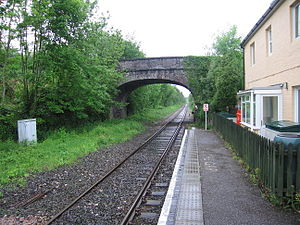Newton St Cyres railway station
 Looking north towards Crediton | |||||
| General information | |||||
| Location | Newton St Cyres, Mid Devon England | ||||
| Coordinates | 50°46′44″N 3°35′21″W / 50.77884°N 3.58915°W | ||||
| Grid reference | SX880989 | ||||
| Managed by | Great Western Railway | ||||
| Platforms | 1 | ||||
| Other information | |||||
| Station code | NTC | ||||
| Classification | DfT category F2 | ||||
| History | |||||
| Original company | Exeter and Crediton Railway | ||||
| Pre-grouping | London and South Western Railway | ||||
| Post-grouping | Southern Railway | ||||
| Key dates | |||||
| Opened | 1851 | ||||
| Passengers | |||||
| 2018/19 | |||||
| 2019/20 | |||||
| 2020/21 | |||||
| 2021/22 | |||||
| 2022/23 | |||||
| |||||
Newton St Cyres railway station is a railway station serving the village of Newton St Cyres, Devon, England. It is served by Great Western Railway trains on the Tarka and Dartmoor lines. It is on the Tarka Line to Barnstaple, 4 miles 21 chains (6.9 km) from Exeter Central at milepost 175.75 from London Waterloo.[1]
History
[edit]The Exeter and Crediton Railway was opened on 12 May 1851 but this, the only intermediate station, was not opened until October 1851.[2] At the time it was named just 'St Cyres'.[3] Only one track was in use at the time due to a dispute a dispute over the track gauge and this served the platform on the north side of the railway.[4] The ticket office and facilities were in a wooden building which was probably moved from Cowley where the railway had intended to open a temporary terminus in 1848 but were unable to do so.[5]
The line towards Exeter was doubled and a signal box provided from 23 February 1875, then the line towards Crediton was doubled from 2 June 1875.[6] The station was renamed as Newton St Cyres on 1 October 1913.[2]
The signal box was closed on 17 August 1930 when the signalling equipment was transferred into the booking office. The goods yard closed on 12 September 1960 and the signals taken out of use on 31 July 1968. The line became just a single track again on 16 December 1984.[3]
The platform on the south side is still in place but disused. The former station master's house is now in private use.[2] The former Station Hotel is now named "The Beer Engine". It is the oldest micro-brewery in Devon.[7]
Description
[edit]The station is located next to a bridge that carries a minor road that leads north from the village of Newton St Cyres.[8] The platform that is in use is on the north side of the line and has a waiting shelter. There is no ticket machine or other facilities and the station is unstaffed.[9]
The platform height is significantly lower than many other railway stations on the UK railway network. To reduce the height difference, a Harrington Hump was installed at the station. Trains will only stop adjacent to the hump, with the train guard operating only their local door to allow passengers to board or alight.[citation needed]
Services
[edit]All services at Newton St Cyres are operated by Great Western Railway. Only a limited number of trains (between six and eight each way each day) between Barnstaple or Okehampton and Exeter Central call at Newton St Cyres and this is only on request to the conductor or by signalling the driver as it approaches.[9]
| Preceding station | Following station | |||
|---|---|---|---|---|
| Exeter St Davids | Great Western Railway (Tarka Line and Dartmoor line) |
Crediton | ||
Community railway
[edit]The railway between Exeter and Barnstaple is promoted as the Tarka Line. It is designated as a community railway and is supported by the Devon and Cornwall Rail Partnership.[10]
References
[edit]- ^ Jacobs, Gerald (2005). Railway Track Diagrams Book 3: Western. Bradford on Avon: Trackmaps. p. 10. ISBN 0-9549866-1-X.
- ^ a b c Oakley, Mike (2007). Devon Railway Stations. Wimbourne: The Dovecote Press. pp. 145–146. ISBN 978-1-904-34955-6.
- ^ a b Nicholas, John (1992). The North Devon Line. Sparkford: Oxford Publishing Company. pp. 13–17. ISBN 0-86093-461-6.
- ^ Nicholas 1992, pp. 92–93
- ^ Garnsworthy, Paul (2013). "Cowley Station". Broadsheet (69): 25–29.
- ^ Nicholas 1992, pp. 111–112
- ^ Barton, Bob (2018). Unusual railway pubs, refreshment rooms and ale trains. Wellington, Somerset: Halsgrove. p. 97. ISBN 978-0-85704-327-6.
- ^ Craske, Peter (2013). Tarka Line Walks. Crimson Books. pp. 18–28. ISBN 978-1-78059-182-7.
- ^ a b "Train Times (D2)" (PDF). Great Western Railway. Retrieved 6 January 2022.
- ^ "Tarka Line". Devon and Cornwall Rail Partnership. Retrieved 3 December 2021.
